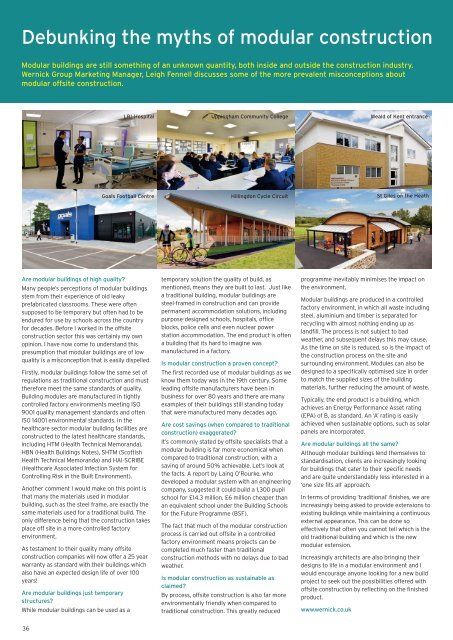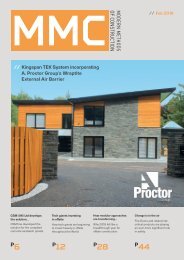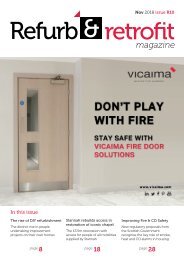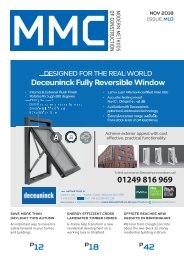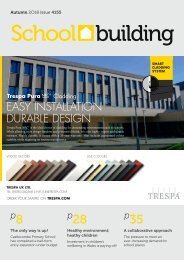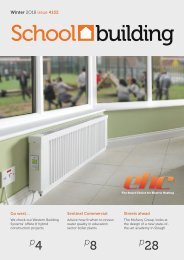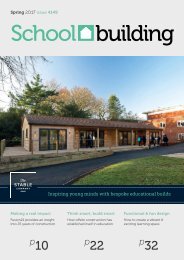Create successful ePaper yourself
Turn your PDF publications into a flip-book with our unique Google optimized e-Paper software.
Debunking the myths of modular construction<br />
Modular buildings are still something of an unknown quantity, both inside and outside the construction industry.<br />
Wernick Group Marketing Manager, Leigh Fennell discusses some of the more prevalent misconceptions about<br />
modular offsite construction.<br />
LRI-Hospital Uppingham Community College Weald of Kent entrance<br />
Goals Football Centre<br />
Hillingdon Cycle Circuit<br />
St Giles on the Heath<br />
Are modular buildings of high quality?<br />
Many people’s perceptions of modular buildings<br />
stem from their experience of old leaky<br />
prefabricated classrooms. These were often<br />
supposed to be temporary but often had to be<br />
endured for use by schools across the country<br />
for decades. Before I worked in the offsite<br />
construction sector this was certainly my own<br />
opinion. I have now come to understand this<br />
presumption that modular buildings are of low<br />
quality is a misconception that is easily dispelled.<br />
Firstly, modular buildings follow the same set of<br />
regulations as traditional construction and must<br />
therefore meet the same standards of quality.<br />
Building modules are manufactured in tightly<br />
controlled factory environments meeting ISO<br />
9001 quality management standards and often<br />
IS0 14001 environmental standards. In the<br />
healthcare sector modular building facilities are<br />
constructed to the latest healthcare standards,<br />
including HTM (Health Technical Memoranda),<br />
HBN (Health Buildings Notes), SHTM (Scottish<br />
Health Technical Memoranda) and HAI-SCRIBE<br />
(Healthcare Associated Infection System for<br />
Controlling Risk in the Built Environment).<br />
Another comment I would make on this point is<br />
that many the materials used in modular<br />
building, such as the steel frame, are exactly the<br />
same materials used for a traditional build. The<br />
only difference being that the construction takes<br />
place off site in a more controlled factory<br />
environment.<br />
As testament to their quality many offsite<br />
construction companies will now offer a 25 year<br />
warranty as standard with their buildings which<br />
also have an expected design life of over 100<br />
years!<br />
Are modular buildings just temporary<br />
structures?<br />
While modular buildings can be used as a<br />
temporary solution the quality of build, as<br />
mentioned, means they are built to last. Just like<br />
a traditional building, modular buildings are<br />
steel-framed in construction and can provide<br />
permanent a<strong>cc</strong>ommodation solutions, including<br />
purpose-designed schools, hospitals, office<br />
blocks, police cells and even nuclear power<br />
station a<strong>cc</strong>ommodation. The end product is often<br />
a building that its hard to imagine was<br />
manufactured in a factory.<br />
Is modular construction a proven concept?<br />
The first recorded use of modular buildings as we<br />
know them today was in the 19th century. Some<br />
leading offsite manufacturers have been in<br />
business for over 80 years and there are many<br />
examples of their buildings still standing today<br />
that were manufactured many decades ago.<br />
Are cost savings (when compared to traditional<br />
construction) exaggerated?<br />
It’s commonly stated by offsite specialists that a<br />
modular building is far more economical when<br />
compared to traditional construction, with a<br />
saving of around 50% achievable. Let’s look at<br />
the facts. A report by Laing O’Rourke, who<br />
developed a modular system with an engineering<br />
company, suggested it could build a 1,300 pupil<br />
school for £14.3 million, £6 million cheaper than<br />
an equivalent school under the Building Schools<br />
for the Future Programme (BSF).<br />
The fact that much of the modular construction<br />
process is carried out offsite in a controlled<br />
factory environment means projects can be<br />
completed much faster than traditional<br />
construction methods with no delays due to bad<br />
weather.<br />
Is modular construction as sustainable as<br />
claimed?<br />
By process, offsite construction is also far more<br />
environmentally friendly when compared to<br />
traditional construction. This greatly reduced<br />
programme inevitably minimises the impact on<br />
the environment.<br />
Modular buildings are produced in a controlled<br />
factory environment, in which all waste including<br />
steel, aluminium and timber is separated for<br />
recycling with almost nothing ending up as<br />
landfill. The process is not subject to bad<br />
weather, and subsequent delays this may cause.<br />
As the time on site is reduced, so is the impact of<br />
the construction process on the site and<br />
surrounding environment. Modules can also be<br />
designed to a specifically optimised size in order<br />
to match the supplied sizes of the building<br />
materials, further reducing the amount of waste.<br />
Typically, the end product is a building, which<br />
achieves an Energy Performance Asset rating<br />
(EPA) of B, as standard. An ‘A’ rating is easily<br />
achieved when sustainable options, such as solar<br />
panels are incorporated.<br />
Are modular buildings all the same?<br />
Although modular buildings lend themselves to<br />
standardisation, clients are increasingly looking<br />
for buildings that cater to their specific needs<br />
and are quite understandably less interested in a<br />
‘one size fits all’ approach.<br />
In terms of providing ‘traditional’ finishes, we are<br />
increasingly being asked to provide extensions to<br />
existing buildings while maintaining a continuous<br />
external appearance. This can be done so<br />
effectively that often you cannot tell which is the<br />
old traditional building and which is the new<br />
modular extension.<br />
Increasingly architects are also bringing their<br />
designs to life in a modular environment and I<br />
would encourage anyone looking for a new build<br />
project to seek out the possibilities offered with<br />
offsite construction by reflecting on the finished<br />
product.<br />
www.wernick.co.uk<br />
36


